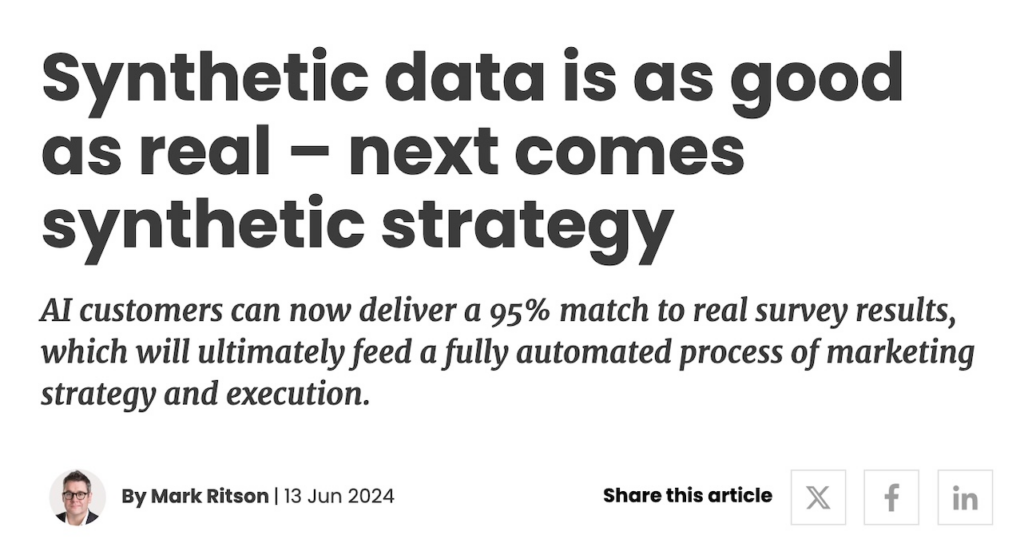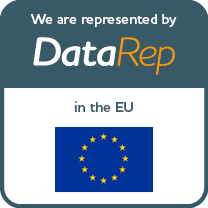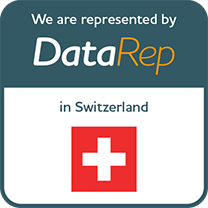When Mark Ritson says, “Jump”, the marketing sector doesn’t just ask, “How high?”; it gets its trainers on and starts limbering up. So it’s not a surprise that his latest article in Marketing Week this month has had a bit of an impact, to put it mildly.
He described the leap forward made by Evidenza, a company in which he has a minority interest, in creating synthetic respondents, and he reveals that in tests, “AI customers can now deliver a 95% match to real survey results”. The company focuses on both qualitative and quantitative research in B2B, but these results have implications for B2C research too.
Ritson says that this is “bad news for market research companies because they are likely to experience a steam-train decade of oncoming paranoia, pressure and partial obsolescence”.
The article has provoked what we will call healthy debate at The Forge. So we wanted to share our thoughts about the role of AI and synthetic respondents, and the future of market research.

The Rise of AI in Market Research
Like Ritson, we need to declare an interest. We’ve partnered with Jonathan Williams as he creates One Strategy Studio, an AI-powered strategy, insight and innovation agency. So we’re huge advocates and massive fans of AI and its potential.
AI has already demonstrated immense value across the insight, strategy and innovation value chain. From generating insights territories to creating innovation platforms and bringing creative ideas to life, AI’s capabilities continue to expand.
The introduction of synthetic respondents promises to further revolutionise the field by enabling conversations with thousands of ‘people’ about their needs, behaviours, and attitudes across a wide range of categories, markets, and subjects at unprecedented speed and scale.
This technological advancement could be a game-changer for the strategy and consulting industry. Imagine a world where a small startup can gain the same depth of consumer insight as a multinational corporation, or where a company can continually refresh its market segmentation to keep up with shifting consumer behaviours.
We believe these will create more opportunities for the industry to create value. But that is not the whole story.

The Irreplaceable Value of Human Insight
Despite these advancements, we believe that human insight will continue to create value for businesses and brands. As AI continues to develop, there are still some areas where human input will improve the output, as follows:
1. Uncovering the Unsaid
In research, what is said is often only half of the story. There are incredibly potent insights to be uncovered in the things that are left out. There are many topics too boring, routine, taken-for-granted, or taboo, that won’t necessarily be talked about, but could be invaluable to brands looking to better serve our needs.For example, women’s health issues and people’s household care routines are currently under-represented by current generative AI. These models have been trained on the web, and because these topics are taboo or mundane, they are missing from the online conversation. This will no doubt change in the future, as more and more of our lives are captured and stored as data, but until AI has been trained on all of what we say, and crucially, don’t say, human insight will be required to give us a complete picture.
2. Addressing the Say-Do Gap
Even when people are happy to share, we often say one thing and do another, especially when talking about socially desirable topics; how actively we recycle or whether we feed our children processed foods, for example.One of the techniques we use to overcome the say-do gap is to observe people through ethnography. For example, we recently conducted a video community with parents to understand what their young children were eating over several days. This gave us a picture of where the gaps were between parental aspiration and in-the-moment reality; what people actually do is influenced by cooking ability, time and available products, as well as the challenges they face in-the-moment in getting food on the table and getting their children to eat it. This was incredibly helpful for us as we built out an innovation roadmap for the client.Until AI is also able to reflect what we do (not just what we say) then human insight will continue to be an invaluable input into our strategy projects.
3. Understanding Cultural Context
Within cultures, there are many expectations and ‘norms’ that people don’t think to unpack or explain. Examples include assumptions about health, family dynamics or even the rhythm of the week.
For example, concern in the US with costs of insurance can mean bigger concerns about discussing long-term chronic conditions in market research. Likewise, in Eastern markets, strong ‘fast-acting’ tablets can be seen as at odds with holistic traditional medicine, which means the messaging will need to adapted to fit with the local culture.
Until AI can capture the full spectrum of cultural nuance, which we believe is some way off, we see humans playing a critical role in ensuring that insights, strategies and ideas land effectively and create enduring value for clients and their consumers.
4. Translating Insights into Empathetic Solutions
In our strategy consulting, we have two key use cases for consumer insight. First, we want to understand more about of the needs, attitudes and behaviours of the people that we are targeting with our strategies.
Second, we use it to bring to life these insights so we can emotionally immerse our clients in consumers’ lives. By deeply understanding the people we are solving for, we help bring our clients closer to the problems that they face, which leads to better, less abstract solutions.
We believe the power of using real people will continue to create human-to-human empathy between the marketers solving the problem and the people they are solving them for.
5. Landing Insights in the Boardroom
Those with most power to change things are often those furthest away from the people that need their help.
Human understanding research can bring the empathy and the stories that get the insight to land in the boardroom. We find this over and over again. Often, the most potent parts of our strategies are the human touches – expert interviews, ethnography, cultural analysis. These elements connect in a visceral way that doesn’t come from just looking at a demand space.
For example, we recently worked with a global healthcare brand to deliver a complex piece of work looking at growth and strategic direction. But the moment that the research really hit home in the boardroom was the moment that we brought it to life with films of real people talking.
It’s our view that real people sharing real stories will continue to create momentum for some time to come.
Conclusion
At The Forge, we believe that insight is forged, not found. Data and inputs can come from many sources— qualitative, quantitative, semiotics, ethnography, foresight, experts, etc. Each source illuminates a different piece of the puzzle. AI is a valuable tool, offering another perspective, but it’s not the whole picture. And synthetic respondents are yet another tool that can help to drive down costs and deliver faster insights.
The coming decade will be one of change for the market research sector. It may even feel like a steam train at times. But it’s clear to us that there is a future and that it lies in the integration of AI and human insight. AI can process vast amounts of data quickly, and more cheaply. However human insight helps us connect more deeply with empathy, interrogate and challenge what we are seeing and hearing, and join the dots. Together, they can provide a richer and more complete picture of consumer behaviour.


